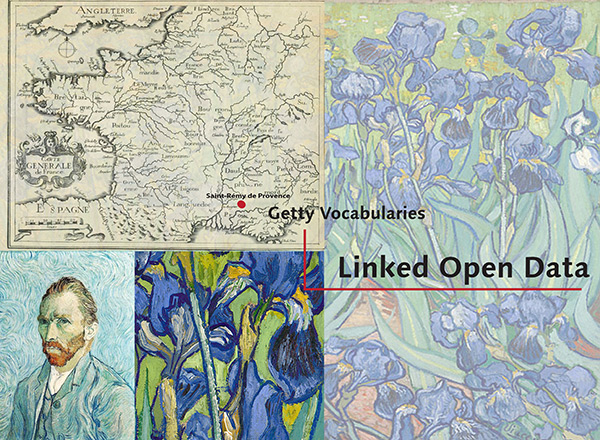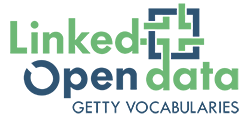
We’re delighted to announce that today, the Getty has released the Art & Architecture Thesaurus (AAT)® as Linked Open Data. The data set is available for download at vocab.getty.edu under an Open Data Commons Attribution License (ODC BY 1.0).
The Art & Architecture Thesaurus is a reference of over 250,000 terms on art and architectural history, styles, and techniques. It’s one of the Getty Research Institute’s four Getty Vocabularies, a collection of databases that serves as the premier resource for cultural heritage terms, artists’ names, and geographical information, reflecting over 30 years of collaborative scholarship. The other three Getty Vocabularies will be released as Linked Open Data over the coming 18 months.
In recent months the Getty has launched the Open Content Program, which makes thousands of images of works of art available for download, and the Virtual Library, offering free online access to hundreds of Getty Publications backlist titles. Today’s release, another collaborative project between our scholars and technologists, is the next step in our goal to make our art and research resources as accessible as possible.
What Is Linked Open Data?
 Linked Open Data is a way of publishing information so it can be connected with other information (linked) and freely used (open). Making data both linked and open makes it widely accessible and easy to recombine with information from other sources to create new knowledge. (For a great demonstration of Linked Open Data, see this video from Europeana.)
Linked Open Data is a way of publishing information so it can be connected with other information (linked) and freely used (open). Making data both linked and open makes it widely accessible and easy to recombine with information from other sources to create new knowledge. (For a great demonstration of Linked Open Data, see this video from Europeana.)
Publishing information as Linked Open Data unlocks the full knowledge potential of databases, allowing researchers to access, query, and recombine data created and stored by institutions of all kinds—libraries, museums, archives, laboratories, universities, research centers, governments, publishers, and others. It is a tool with enormous potential to advance scholarship, within the humanities and beyond.
Why Does Linked Open Data Matter?
Because Linked Open Data is specifically structured to “talk” to other data across the Internet, it makes new webs of connections, and therefore new discoveries, possible.
Let’s take a work of art—Van Gogh’s Irises—as just one example. Linked data makes it possible to find information available globally about Van Gogh—images and information about his other works previous owners, conservation treatments, exhibitions, other artists in his circle, current events at the time and place he painted Irises, letters and primary documents, sales records, the location of the actual painting, and more.
What’s Next
Over the next 18 months, the Research Institute’s other three Getty Vocabularies—The Getty Thesaurus of Geographic Names (TGN)®, The Union List of Artist Names®, and The Cultural Objects Name Authority (CONA)®—will all become available as Linked Open Data. To follow the progress of the Linked Open Data project at the Research Institute, see their page here.
The release of the Vocabularies as Linked Open Data will help link cultural heritage information across cultures and between disciplines, leading to new advances in the humanities. I am always delighted to see the new ideas and profound revelations that come from cultural research—and I’m especially excited to see what this 21st-century approach to research will yield.
As always, we welcome comments and input from the user community. If you have a suggestion or find the Getty’s Linked Open Data useful in your own work, please share it here or email the Getty’s Linked Open Data team at vocabLOD@getty.edu.




Fantastic! This is a great moment for all of us working on and using the AAT for so long now. A new chapter is ready to begin. Cheers from your colleagues from the Netherlands. Nice to see Vincent van Gogh used as an exemple in your article 🙂
This is great!
I’m working on generating linked data (bibframe) from our catalog. We have aat terms that are probably the English skos:prefLabel. How do I use the site to look up a preflabel and get back the uri? I only see the html lookup; is there a way to get back rdf results using content negotiation or something?
Thanks, Nate
——————————————-
Nate Trail
——————————————-
LS/TECH/NDMSO
Library of Congress
Hi Nate, Thanks for your question! This answer is via our software architect Joan Cobb:
You should eventually do this from a program—and if you need help with that you can write us directly at VocabLOD@getty.edu. But you can also see an example of how it’s done by experimenting with the SPQRQL query page on vocab.getty.edu by doing the following:
You might also want to try the sample “Subject by Language Independent Term Field.”
Hope this helps!
Hi Nate!
– Joan answered how to search with FTS, eg ?subject luc:term “vessel*” and indeed this is most efficient for interactive searching, eg for autocomplete (don’t use regexp() !). But this will return also altLabels, and variants like “vessels”
– I assume your labels are in English. If also you expect exact matches, you can just use ?subject skos:prefLabel “vessel”@en. That’s fastest than FTS, since there’s an index by literals.
– But some subjects (loan terms) may not have a prefLabel in en. So you can use gvp:prefLabelGVP/skosxl:literalForm, and strip the lang tag when comparing. This is slower, because there’s no index by “literal without lang tag”.
DO READ the documentation. There’s even a section about coreferencing to LCSH (but only 300 are coreferenced). Contact me if I can be of help.
Looking forward to building several test methods for delivering applications. Another big step forward for linked open data!
chris cabrera thompson, ucla library
This is fantastic!
I wonder how does the AAT becoming LOD influence its translation (or the coordination of translations) as there now might be bigger interest in translating AAT and using it also in smaller languages? I for instance am from Estonia and I would like to promote the implementation of AAT in our heritage sector (in the heritage portals etc).
This is great. Congratulations. Looking forward to link to it.
The ImageSnippets application is thrilled that you published this as LOD. We have just added the AAT as a dataset in our tool for adding metadata tags to images!
Excellent news and kudos to the Getty for this bold move! The Art & Architecture Thesaurus will certainly find a good home and good company in the growing corpora of open linked data across the web. For my part, I’m looking forward to the opening of the Thesaurus of Geographic Names (TGN). This one-of-a-kind resource will be a tremendous boon to (computational) geography. Hats off to you.